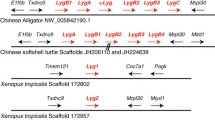Summary
Parsimony trees relating DNA sequences coding for lysozymesc and α-lactalbumins suggest that the gene duplication that allowed lactalbumin to evolve from lysozyme preceded the divergence of mammals and birds. Comparisons of the amino acid sequences of additional lysozymes and lactalbumins are consistent with this view. When all base positions are considered, the probability that the duplication leading to the lactalbumin gene occurred after the start to mammalian evolution is estimated to be 0.05–0.10. Elimination of the phylogenetic noise generated by fast evolution and compositional bias at third positions of codons reduced this probability to 0.002–0.03. Thus the gene duplication may have long preceded the acquisition of lactalbumin function.
Similar content being viewed by others
References
Beg OU, von Bahr-Lindström H, Zaidi ZH, Jörnvall H (1985) The primary structure of α-lactalbumin from camel milk. Eur J Biochem 147:233–239
Bernardi G, Bernardi G (1986) Compositional constraints and genome evolution. J Mol Evol 24:1–11
Castañón MJ, Spevak W, Adolf GR, Chlebowicz-Sledziewska E, Sledziewski A (1988) Cloning of human lysozyme and expression in the yeastSaccharomyces cerevisiae. Gene 66:223–234
DeSalle R, Freedman T, Prager EM, Wilson AC (1987) Tempo and mode of sequence evolution in mitochondrial DNA of HawaiianDrosophila. J Mol Evol 26:157–164
Engström Å, Xanthopoulos KG, Boman HG, Bennich H (1985) Amino acid and cDNA sequences of lysozyme fromHyalophora cecropia. EMBO J 4:2119–2122
Hall L, Craig RK, Edbrooke MR, Campbell PN (1982) Comparison of the nucleotide sequence of cloned human and guineapig pre-α-lactalbumin cDNA with that of chicken pre-lysozyme cDNA suggests evolution from a common ancestral gene. Nucleic Acids Res 10:3503–3514
Hayssen V, Blackburn DG (1985) α-lactalbumin and the origins of lactation. Evolution 39:1147–1149
Jollès P, Jollès J (1984) What's new in lysozyme research? Mol Cell Biochem 63:165–189
Jollès J, Sen A, Prager EM, Jollès P (1977) Structural data concerning reptilian (tortoise) egg lysozyme. J Mol Evol 10:261–264
Jollès J, Ibrahimi IM, Prager EM, Schoentgen F, Jollès P, Wilson AC (1979a) Amino acid sequence of pheasant lysozyme. Evolutionary change affecting processing of prelysozyme. Biochemistry 18:2744–2752
Jollès J, Schoentgen F, Croizier G, Croizier L, Jollès P (1979b) Insect lysozymes from three species of Lepidoptera: their structural relatedness to the c (chicken) type lysozyme. J Mol Evol 14:267–271
Jollès P, Schoentgen F, Jollès J, Dobson DE, Prager EM, Wilson AC (1984) Stomach lysozymes of ruminants. II. Amino acid sequence of cow lysozyme 2 and immunological comparisons with other lysozymes. J Biol Chem 259:11617–11625
Jung A, Sippel AE, Grez M, Schütz G (1980) Exons encode functional and structural units of chicken lysozyme. Proc Natl Acad Sci USA 77:5759–5763
Kaminogawa S, McKenzie HA, Shaw DC (1984) The amino acid sequence of equine α-lactalbumin. Biochem Int 9:539–546
Kumagai I, Tamaki E, Kakinuma S, Miura K-I (1987) Molecular cloning and sequencing of cDNA encoding goat pre α-lactalbumin. J Biochem 101:511–517
Lake JA (1987) A rate-independent technique for analysis of nucleic acid sequences: evolutionary parsimony. Mol Biol Evol 4:167–191
McKenzie HA, Shaw DC (1985) The amino acid sequence of equine milk lysozyme. Biochem Int 10:23–31
McKenzie HA, White FH Jr (1987) Studies of a trace cell lytic activity associated with α-lactalbumin. Biochem Int 14:347–356
Nitta K, Tsuge H, Sugai S, Shimazaki K (1987) The calciumbinding property of equine lysozyme. FEBS Lett 223:405–408
Pervaiz S, Brew K (1986) Purification and characterization of the major whey proteins from the milks of the bottlenosed dolphin (Tursiops truncatus), the Florida manatee (Trichecus manatus latirostris) and the beagle (Canis familiaris). Arch Biochem Biophys 246:846–854
Preparata G, Saccone C (1987) A simple quantitative model of the molecular clock. J Mol Evol 26:7–15
Qasba PK, Safaya SK (1984) Similarity of the nucleotide sequences of rat α-lactalbumin and chicken lysozyme genes. Nature 308:377–380
Rodríguez R, Menéndez-Arias L, González de Buitrago G, Gavilanes JG (1985) Amino acid sequence of pigeon egg-white lysozyme. Biochem Int 11:841–843
Rodríguez R, Menéndez-Arias L, González de Buitrago G, Gavilanes JG (1987) Structure of the pigeon lysozyme and its relationship with other typec lysozymes. Comp Biochem Physiol 88B:791–796
Sarich VM (1985) Rodent macromolecular systematics. In: Luckett WP, Hartenberger J-L (eds) Evolutionary relationships among rodents. A multidisciplinary analysis. Plenum, New York, pp 423–452
Shewale JG, Sinha SK, Brew K (1984) Evolution of α-lactalbumins. The complete amino acid sequence of the α-lactalbumin from a marsupial (Macropus rufogriseus) and corrections to regions of sequence in bovine and goat α-lactalbumins. J Biol Chem 259:4947–4956
Spicer SS, Erlandsen SL, Wilson AC, Hammer MF, Hennigar RA, Schulte BA (1987) Genetic differences in the histochemically defined structure of oligosaccharides in mice. J Histochem Cytochem 35:1231–1244
Stewart C-B, Schilling JW, Wilson AC (1987) Adaptive evolution in the stomach lysozymes of foregut fermenters. Nature 330:401–404
Stuart DI, Acharya KR, Walker NPC, Smith SG, Lewis M, Phillips DC (1986) α-lactalbumin possesses a novel calcium binding loop. Nature 324:84–87
Swofford DL (1985) Phylogenetic analysis using parsimony (PAUP), Version 2.4 Illinois Natural History Survey, Champaign, IL
White TJ, Mross GA, Osserman EF, Wilson AC (1977) Primary structure of rat lysozyme. Biochemistry 16:1430–1436
Wilson AC, Carlson SS, White TJ (1977) Biochemical evolution. Annu Rev Biochem 46:573–639
Wilson AC, Ochman H, Prager EM (1987) Molecular time scale for evolution. Trends Genet 3:241–247
Author information
Authors and Affiliations
Rights and permissions
About this article
Cite this article
Prager, E.M., Wilson, A.C. Ancient origin of lactalbumin from lysozyme: Analysis of DNA and amino acid sequences. J Mol Evol 27, 326–335 (1988). https://doi.org/10.1007/BF02101195
Received:
Revised:
Accepted:
Issue Date:
DOI: https://doi.org/10.1007/BF02101195




